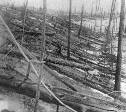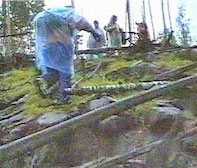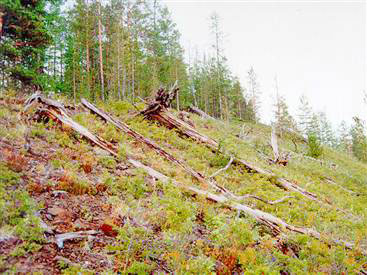|


Members of the scientific expedition of the Siberian state
foundation Tunguska Space Phenomenon say they have managed to
uncover blocks of an extraterrestrial technical device. The
space body, which was later called the Tunguska meteorite,
fell down on Earth on June 30th 1908, 65 kilometers off
the Vanavara settlement, the Evenkiya republic.
 The
first expedition to study the Tunguska meteorite was organized in
1927. Professor Leonid Kulik headed the mission. However,
explorers have never managed to discover any fragments of the
celestial body. The
first expedition to study the Tunguska meteorite was organized in
1927. Professor Leonid Kulik headed the mission. However,
explorers have never managed to discover any fragments of the
celestial body.
The press service of the Evenkiya republic administration
reported the expedition worked in the western part of the region in
the summer of the current year. The mission’s itinerary was based on
the results of the space footage analysis. Explorers believe they
have discovered blocks of an extraterrestrial technical device,
which crashed down on Earth on June 30th, 1908. In
addition, expedition members found the so-called "deer" - the
stone, which Tunguska eyewitnesses repeatedly
mentioned in their stories. Explorers delivered a 50-kilogram piece
of the stone to the city of Krasnoyarsk
to be studied and analyzed.
It is generally believed a giant ball of fire flew above Central
Siberia before the Tunguska meteorite blast. Scientists have
analyzed hundreds of eyewitnesses’ stories and revealed a still
inexplicable detail. Thunder-like sounds and incredible light
effects were seen not only during and after the bolide flight,
but also before it. Several eyewitnesses, including a political
exile (a highly-educated individual), mentioned that in their
stories. It is very hard to explain it with subjective mistakes,
because such affirmations reiterate independently. Observers were
located tens of kilometers far from the area of the fall. A
ballistic wave could not create such a sound: it could remain behind
the bolide, but it could never outdistance it. The only real
explanation can be linked with powerful electromagnetic phenomena,
albeit scientists have not developed a complete analysis of the
issue from this point of view.
Another circumstance is tied with the direction of the body’s
movement. On the ground of eyewitnesses’ testimonies collected in
the 1920s and 1930s, scientists concluded the bolide had
flown northwards from the south. The analysis of the
woods destruction, though, testified to the westwards movement of
the body from the east. It is noteworthy it is the direction
that can be traced in eyewitnesses’ stories.
The discrepancy is evident. A lot of scientists have tried to
explain the mysterious phenomenon using various approaches. It was
particularly said several bolides had flown above the Siberian woods
in 1908. This point of view seems to be rather unfounded - no
eyewitness could see several bolides in one day. Another theory
provoked a discussion in the scientific world, when professor
F.Zigel proposed the meteorite maneuvered in the
Earth’s atmosphere. It would be possible to discuss the theory
only if the Tunguska meteorite was a man-caused catastrophe.
The meteorite flight culminated in the powerful blast up to 40 Mt of
trotyl equivalent.
Return
Members of a Russian scientific team researching the site of the
Tunguska meteorite crash of 1908 say they have
found remnants of an extraterrestrial spacecraft,
report a variety of Russian news agencies.
The object appeared to be a large metallic block, according
to the reports. The researchers chipped off a piece of the object
and will now test its composition.
One scientist said based on his calculations, the mass of the space
object headed for Earth in 1908 was nearly 1 billion tons. He
believes the meteorite was blasted by the spaceship at an altitude
of 10 kilometers to prevent the destruction of all humanity on the
planet.
"I am fully confident and I can make
an official statement that we were saved by some forces of a
superior civilization," Yuri Lavbin said. "They
exploded this enormous meteorite that headed towards us with
enormous speed," he said. "Now this great object
that caused the meteorite to explode is found at last. We will
continue our research," he added.
 Lavbin
says that the results of this year’s expedition give him hope that
the Tunguska mystery will be solved before the phenomenon’s
100th anniversary. To do this, Russian researchers plan
another large-scale expedition to the Eastern Siberia. Lavbin
says that the results of this year’s expedition give him hope that
the Tunguska mystery will be solved before the phenomenon’s
100th anniversary. To do this, Russian researchers plan
another large-scale expedition to the Eastern Siberia.
The scientific team says the Tunguska event was an
aerial explosion that occurred near the Tunguska River
in Siberia June 30, 1908. The blast felled an
estimated 60 million trees over 2,150-square kilometers. Local
residents observed a huge fireball, almost as bright as the
Sun, moving across the sky. A few minutes later, there was a flash
that lit up half of the sky, followed by a shock wave that knocked
people off their feet and broke windows up to 400 miles away.
The explosion registered at seismic stations across Eurasia, and
produced fluctuations in atmospheric pressure strong enough to be
detected by the recently invented barographs in Britain. Over the
next few weeks, night skies over Europe and western Russia glowed
brightly enough for people to read by. In the United States, the
Smithsonian Astrophysical Observatory and the Mount Wilson
Observatory observed a decrease in atmospheric transparency that
lasted for several months.
The size of the blast was later estimated to be between 10 and 15
megatons. Until this year members of numerous expeditions have
failed to find any remains of the object that caused the event.
Return
HOUSTON - A flurry of reports from Russia about the discovery of
fragments of an alien spaceship at the site of the
1908 Tunguska explosion may be nothing more than wish
fulfillment by devotees of a half-century-old Russian space myth, or
they may actually have been based on genuine spacecraft fragments —
but of Russian origin.
Either way, or even in the highly unlikely event the reports turn
out to be credible, these stories reflect the way the century-old
Tunguska blast continues to resonate in the human psyche.
Expedition leader Yuri Lavbin prefers the alien technology
interpretation. That’s the theory he admits he started with,
even before he got to the area. But other space experts have pointed
out that the region is a drop zone for discarded rocket stages
launched into space from Russia’s Baikonur base, and in fact
was the crash site of one prototype manned space capsule at the very
dawn of the space age.
|

Almost a century
after the 1908 Tunguska explosion, flattened trees still
cover the Siberian landscape. |
On June 30, 1908, residents of
southern Siberia spotted a dazzling fireball
crossing the sky, followed by a flare brighter than the sun.
Minutes later, a shock wave knocked many of those residents
off their feet.
When later expeditions reached
the nearly inaccessible swamps where the explosion had
occurred, they found trees flattened down in a pattern
pointing away from ground zero — but no crater, and no
meteorite fragments.
The first Soviet expedition was sent to the site in 1927, in
hopes of finding metallic ore. Although a series of natural
theories followed over the years, a Russian scientist and
science-fiction author who visited Hiroshima in late 1945
postulated that the Tunguska blast, too, must
have been nuclear in nature — and hence, the result of a
visit by space aliens. |
But Dutch space historian Geert
Sassen suggests an earthly origin for the space fragments
reportedly just found, and they could well have no connection with
the 1908 event. “They might have found some parts of the fifth
Vostok test flight,” he told associates via e-mail.
Sassen was referring to a flight on Dec. 22, 1960, meant to
carry two dogs into space. According to “Challenge to Apollo,”
NASA’s definitive history of the space race,
"the payload landed about 3,500
kilometers downrange from the launch site in one of the most
remote and inaccessible areas of Siberia, in the
region of the Podkamennaya Tunguska River close to
the impact point of the famed Tunguska meteorite."
A team of space engineers located the
capsule, disarmed the destruct system, and rescued the canine
passengers.
Natural explanations
Initially, astronomers were attracted to the idea that the object
had been a comet nucleus, to account for the explosion when
it slammed into the atmosphere. They toyed with other theories,
including proposals involving antimatter and “mini-black
holes,” but for many years there were no reliable theories on
what happens when large objects hit Earth’s atmosphere.
That changed in the 1980s, as observations of artificial and
natural fireballs expanded, along with the power of computer
simulations.
“When the first modern models for
atmospheric impacts were published in 1993,” NASA
asteroid expert David Morrison said, “it became clear
that this was a stony body.” He suggested that it was “somewhere
between an ordinary chondrite and a carbonaceous
chondrite in physical properties.”
Return
MOSCOW (AFP) - A Russian scientist has reopened the controversy over
a gigantic explosion in 1908 in Siberia with a claim
that he has found debris from an extraterrestrial space vehicle,
or UFO, which collided with a comet.
On June 30, 1908 a colossal flash lit up the sky over Siberia,
followed by an explosion with the power of a thousand atom bombs. It
obliterated the taiga (forest) for hundreds of square kilometers
(miles) in the basin of the river Podkamennaya Tunguska
in the Krasnoyarsk region.
People living in the villages of Siberia thought there
had been an earthquake. Humans and animals were thrown to the
ground by the shockwave, windows were blown in.
No meteorite debris was found and scientists conclude that
the core of a comet or an asteroid had exploded.
Researcher Yuri Lavbin has spent 12 years researching the
mystery of the "Tunguska meteorite" and believes he has found
the key to one of the great scientific enigmas of the last century,
though many scientists remain skeptical.
He is president of the "Tunguska Spatial Phenomenon"
Foundation in Krasnoyarsk, made up of some 15
enthusiasts, among them geologists, chemists, physicists and
mineralogists, who have been organizing regular expeditions to the
area since 1994.
Lavbin’s theory is that a comet and a mysterious flying
machine collided 10 kilometers (six miles) above the earth’s surface
causing the explosion.
He and his team say that on an expedition to the Podkamannaya
Tunguska river in July they found, between two villages,
two strange black stones in the form of regular cubes
with their sides measuring a meter and half (five feet).
These stones,
"are manifestly not of natural
origin," Lavbin says. They appear to have been fired
and "their material recalls an alloy used to make
space rockets, while at the beginning of the 20th
century only planes made of plywood existed."
He claims that the cubes are the
remains of a flying machine, perhaps an extraterrestrial
spaceship, while admitting that an analysis of the stones has
yet to be undertaken.
He found something else: a huge white stone "the size
of a peasant’s hut" stuck in the top of a crag in the middle of the
devastated forest.
"Local people call it the ’reindeer
stone’. It is made of a crystalline matter which is
not typical of this region," Lavbin said. He suggests it
is part of the core of a comet.
The scientific establishment is not
convinced.
"There are plenty of amateurs who
organize trips to the site of the Tunguska cataclysm,"
said Anna Skripnik of the meteorites committee of the
Academy of Sciences.
"In Siberia where oil geologists regularly work
you can find a heap of fragments of various machines."
Lavbin is not deterred. He
produces satellite photos of the region to back his theory which
show the "footprints" of the spaceship (long marshes
and lakes) and of the comet (devastated forests, charred
trees and smashed rocks).
Not to mention a crater 500 meters (yards) across.
|


 The
first expedition to study the Tunguska meteorite was organized in
1927. Professor Leonid Kulik headed the mission. However,
explorers have never managed to discover any fragments of the
celestial body.
The
first expedition to study the Tunguska meteorite was organized in
1927. Professor Leonid Kulik headed the mission. However,
explorers have never managed to discover any fragments of the
celestial body. 
 Lavbin
says that the results of this year’s expedition give him hope that
the Tunguska mystery will be solved before the phenomenon’s
100th anniversary. To do this, Russian researchers plan
another large-scale expedition to the Eastern Siberia.
Lavbin
says that the results of this year’s expedition give him hope that
the Tunguska mystery will be solved before the phenomenon’s
100th anniversary. To do this, Russian researchers plan
another large-scale expedition to the Eastern Siberia.
